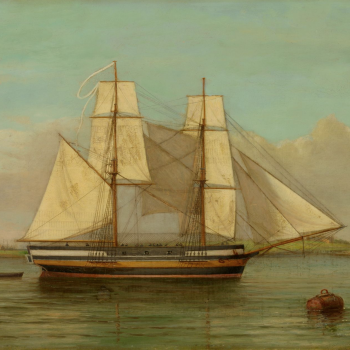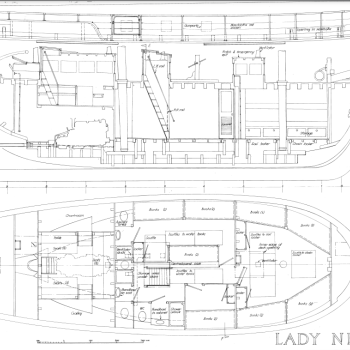1800-1824
H.M.S. Lady Nelson and the part she played in the Colonies of New South Wales, Norfolk Island and Van Diemen's Land
Three weeks after the arrival of the First Fleet at Botany Bay in January 1788 Lieutenant King and a party of 23 were dispatched by Governor Phillip to Norfolk Island to take possession and establish a settlement there.
From this small beginning the population grew slowly until the Sirius was wrecked in March 1790 swelling the number overnight to 497. This caused many problems, as there was not a ship available to take the soldiers and sailors back to Port Jackson.
Over the next 20 years the population rose and fell depending on the number of convicts that were sent there. The numbers of free people on the island also grew as a large number of the convicts became free, married and reared families.
The H.M.S. Lady Nelson was to play a large roll in the lives of the Norfolk Islanders over the coming years. This small 60ton brig had sailed from England in 1800 and was the first vessel to pass through Bass Straight from west to east, reducing the sailing time to Sydney by many days, and dispensing of having to sail around the south coast of Van Diemen's Land .
For the next few years the Lady Nelson was kept busy sailing as a tender under the British flag. After her arrival at Port Jackson in December 1800 she sailed again in 1801 and 1802 with instructions to explore Port Phillip Bay .
The following year she was sent to Risdon Cove in the River Derwent with Lt. John Bowen, and assisted him in the first settlement in Van Diemen's Land . Later in 1803 she was ordered to sail to Sorrento in Port Phillip Bay to assist Lt. Col. Collins with his departure to the River Derwent.
From 1803 the Lady Nelson continued her voyages to many places. She delivered dispatches, military personal and convicts back and forth to Norfolk Island as well as her many trips to Port Macquarie and Newcastle.
Again in 1804 the Lady Nelson recorded another first, when she sailed with the Buffalo , Francis and the Integrity to the Tamar River in the north of Van Diemen's Land to establish another new settlement under the British Government.
Evacuees from Norfolk Island began to leave as early as 1805, when five men arrived at Port Dalrymple. It would be another two years before there was any further movement from the island.
One of the Lady Nelson 's longest voyages during this time was when she went to New Zealand in 1806, returning the Maori Chief Te-Pahi to his homeland.
The Lady Nelson was commissioned to bring the first shipment of passengers from Norfolk Island to Hobart Town , arriving there on 29 November 1807 with 34 men, women and children. The next ship to arrive was the Porpoise on 17 January 1808 with 180 passengers also to Hobart Town . Their profiles can be found in Exiled Three Times Over.
The Lady Nelson made her second voyage with a further 50 passengers in March 1808, She was followed by the Estramina who arrived in June 1808 with 62 passengers again all to Hobart Town . The last evacuees to arrive at Hobart Town came on the City of Edinburgh , they numbered 242 and theirs was the longest and most difficult voyage of all. It took them nearly a month to reach Hobart Town and most of them with only rags on their backs and very little food on board.
In total there were 568 men, women and children (most of them free by this time) who arrived in the River Derwent during the twelve months, making life in the four year old settlement very difficult. Lt Colonial Collins in Hobart Town was having an extremely difficult time feeding those that had arrived in 1804 and well as those who arrived in the Colony after that time. He had been told to expect 100 souls from Norfolk Island and now he to feed and cloth nearly 600.
By 1813 the remainder of those still on Norfolk Island were ordered to sail on the Lady Nelson and the Minstrel to the Tamar River where they then walked to Muddy Plains (now Longford) and settled there on their grants of land.
The profiles in the Exiled Three Times Over book gives an example of what life was like for them before and after they arrived in Hobart Town . Some did very well, while a few fell by the wayside. For the majority it was hard work, the land they were granted was difficult to farm due to flooding of the Esk River , yielding hardly enough for them to live on. This resulted in most of having to live off government stores for the first two years.
If the coming of the evacuees made Lt. Governor Collin's life difficult it did do one good thing. There were over 261 young people on board the 5 ships. This added to the very small number of 38 that had arrived with Collins (allowing that a small amount had been born in the 4 years since Collins had arrived) Some of those who arrived from Norfolk Island married members of Collin's party who had arrived on the Ocean in 1804, swelling the populating and giving it new blood to tackle the future of the island within the first year of their arrival. Without this new blood the Colony may have not survived.
Certainly it would have taken many more years for those who arrived in 1804 to multiply with only their few couples to provide more children. The convicts men would have had no hope of finding partners amongst the free arrivals who came with Collins as it was a few years before any marriageable female convicts arrived. When they did it was the worst sent from Sydney to rid that town of their company.
The following generations of the Norfolk Islanders were to struggle for many years but in time most of them were to become valued citizens and their descendants now number in the thousands. Many of these descendants live in Tasmania while others can be found all over the world, many still carrying their convict ancestor's names.
This brave little ship's life nearly came to an end when at Port Macquarie she holed on some rocks in 1821 and was left to her fate. That was until Governor Macquarie, on one of his official trips to Newcastle , saw her and asked what she was doing there. When told she was holed her ordered her to be brought up on the beach and repaired. Both Macquarie and Mrs Macquarie had a soft spot for the Lady Nelson , having sailed on her to Hobart Town in 1811. It was said that they thought her the safest ship they had ever sailed on.
The Lady Nelson continued her work along the east coast of Australia under many colourful Captain (some ex-convicts) until she was commissioned to sail to Port Dundas at the northern part of Australia in 1824 to again help with a new settlement.
This voyage was to be her swan song, on arriving in the north she was sent to the Timor Sea in an attempt to buy pigs for the new settlement. While on the island of Baba the Lady Nelson was overrun with islanders, the crew was killed and the ship stripped and later burnt and sunk. This was the end of the Lady Nelson , who had been the Colony's work-horse for over twenty-four years. Surely one of the ships worthy of respect then, as the replica is now.
Irene Schaffer 2006



